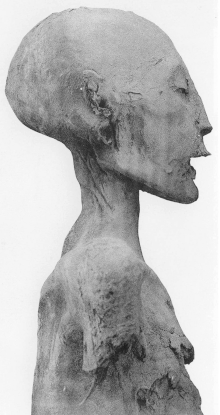This article needs additional citations for verification. (April 2024) |
| "The Younger Lady" | |
|---|---|
 Right profile view of the mummy from KV35 | |
| Burial | |
| Spouse | Akhenaten |
| Issue | Tutankhamun |
| Dynasty | Eighteenth of Egypt |
| Father | Amenhotep III |
| Mother | Tiye |
| Religion | Ancient Egyptian Religion |
The Younger Lady is the informal name given to an ancient Egyptian mummy discovered within tomb KV35 in the Valley of the Kings by archaeologist Victor Loret in 1898.[1] The mummy also has been given the designation KV35YL ("YL" for "Younger Lady") and 61072, and currently resides in the Egyptian Museum in Cairo. Through recent DNA tests, this mummy has been identified as the mother of the pharaoh Tutankhamun and a daughter of pharaoh Amenhotep III and his Great Royal Wife Tiye. Early speculation that this mummy was the remains of Nefertiti was argued to be incorrect,[2] as nowhere is Nefertiti accorded the title "King's daughter"[3] unless this mummy was in fact a cousin of Akhenaten and not a sister [4]
- ^ Reeves, Nicholas; Wilkinson, Richard H. (1996). The Complete Valley of the Kings: Tombs and Treasures of Egypt's Greatest Pharaohs (2010 paperback ed.). London: Thames and Hudson. p. 100. ISBN 978-0-500-28403-2.
- ^ Cite error: The named reference
pmid20159872was invoked but never defined (see the help page). - ^ "Ray Johnson on the Forensic Reconstruction of the "Younger Lady" | The Oriental Institute of the University of Chicago". oi.uchicago.edu. Retrieved 10 May 2021.
- ^ Eaton-Krauss, Marianne (2016). "Alternative interpretations of the DNA data". The Unknown Tutankhamun.